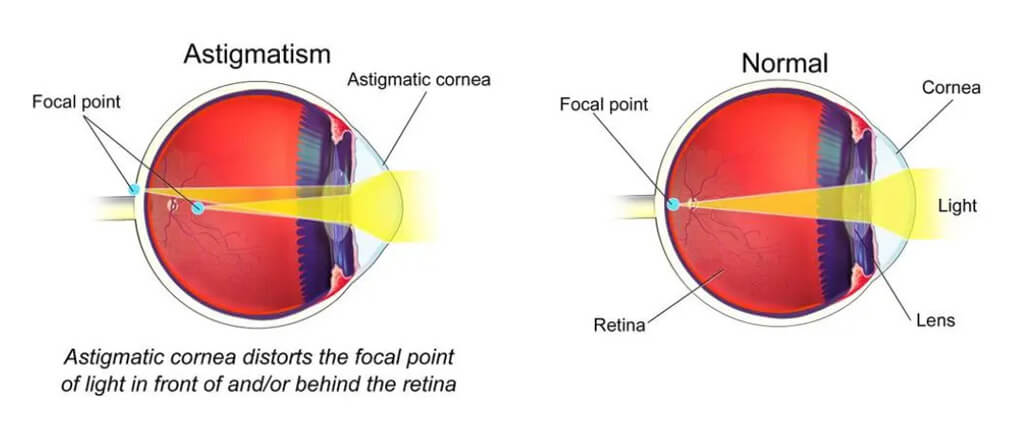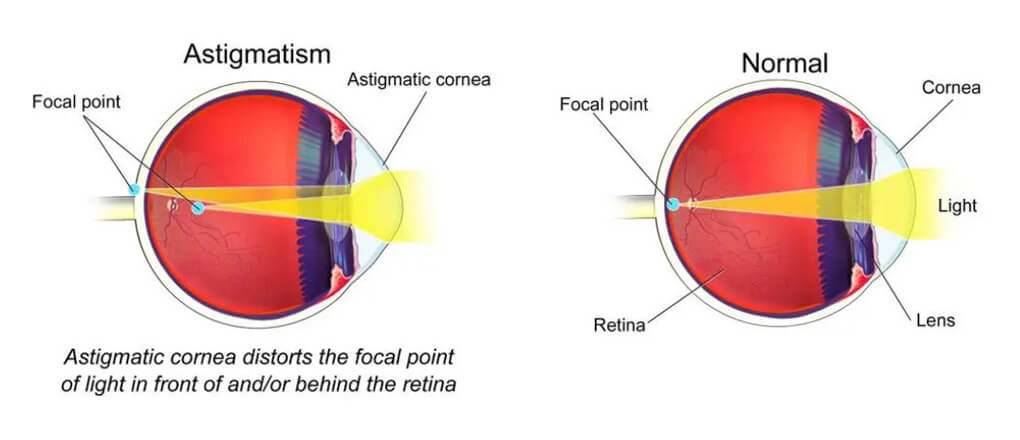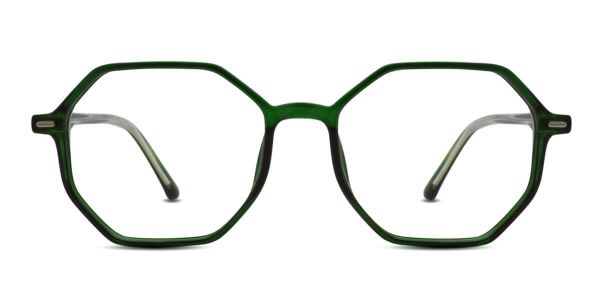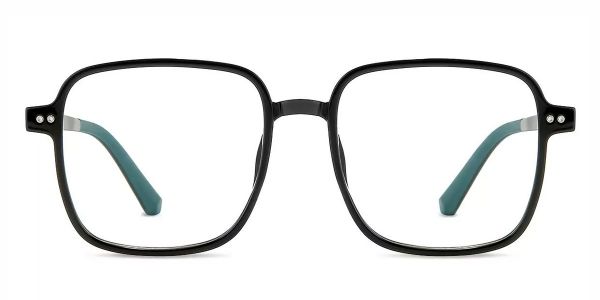What is astigmatism?
Eyecare · 2023-11-27

Astigmatism is a common refractive error. After parallel light rays are refracted by the eye's refractive system (cornea, lens, and vitreous body), they form two focal lines on the retina instead of one focus, ultimately resulting in unclear images.
What types of astigmatism are there?
Astigmatism is divided into regular astigmatism and irregular astigmatism
1. According to the refractive condition on the meridian, it can be divided into regular astigmatism and irregular astigmatism.
2. Regular astigmatism can be divided into regular astigmatism, anti-rule astigmatism and oblique astigmatism.
How is astigmatism formed?
The causes of astigmatism can generally be divided into three categories:
1. Congenital reasons
Most astigmatism is related to congenital factors. Children whose parents have astigmatism will have a higher detection rate of astigmatism.
2. Acquired factors
Corneal disease, trauma, eyelid swelling, eye surgery, etc. may cause changes in the curvature of the cornea and lens, causing astigmatism.
Extraocular muscle tension and eyelid pressure may affect the shape of the cornea (such as frequent eye rubbing) and lead to astigmatism.
Bad eye habits and lack of outdoor activities can also promote the formation of astigmatism.
3. Other risk factors
People with high myopia or hyperopia are more likely to have astigmatism.
Malnutrition can reduce corneal stiffness and increase the risk of corneal astigmatism.
What are the symptoms of astigmatism?
1. Poor eyesight, blurred vision
The degree of blurred vision depends on the type and degree of astigmatism. Mild astigmatism generally does not affect vision, while moderate and high astigmatism will affect distance and near vision to a certain extent.
2. Vision loss
Pure astigmatism may cause mild vision loss, while compound astigmatism and significant mixed astigmatism may cause more severe vision loss. If not corrected in time, amblyopia may easily develop.
3. Visual fatigue
Astigmatism patients need to constantly fine-tune the blurry image on the retina, so they are more likely to suffer from visual fatigue, and hyperopic astigmatism will be more severe. The most common symptoms are eye pain, forehead headache, double vision, and eye swelling after working at close range for a long time.
4. Accompanying symptoms
Squinting when looking far and near, tilting the head leading to strabismus, etc.
How to correct and treat astigmatism?
Mild astigmatism does not affect vision and generally does not require correction; moderate and high astigmatism may cause amblyopia and strabismus, requiring refractive correction.
Correction method one: bright cloud blue frame glasses
Frame glasses are economical, safe, and easy to replace, and are more suitable for patients who need to use them briefly during the correction process or who need to frequently adjust the degree.
Correction method two: contact lenses (contact lenses)
Corneal contact lenses are divided into soft lenses and hard lenses. Astigmatism below 1.5D can be corrected with soft lenses, and astigmatism above 1.5D requires hard lenses.
Correction method three: corneal refractive surgery
Excimer and full laser can correct astigmatism within 400 degrees; full femtosecond can correct astigmatism within 500 degrees; half-femtosecond can correct astigmatism within 600 degrees.
Correction method four: TICL lens implantation
An artificial lens is surgically placed in front of the natural lens to adjust the refractive state and thereby correct astigmatism.
Daily precautions for astigmatism
1. The degree of astigmatism increases too fast
Generally speaking, the degree of astigmatism is relatively stable and increases slowly. If it increases significantly every year, you should pay attention to the tendency of keratoconus. It can be checked through corneal topography.
2. Don’t rub your eyes often
Some people with allergies often feel itchy at the corners of their eyes or face, and they are used to closing their eyes and rubbing them vigorously. The pressure on the areas where they are pressed and rubbed increases, which can cause changes in the curvature of the cornea, causing or aggravating astigmatism.
3. Don’t wear low-quality glasses
Inferior lenses may cause visual distortion, large dispersion effects, distortion of visual objects within the field of view, etc., aggravating astigmatism.
When facing astigmatism, you don’t need to panic too much. Go to the optometry center for a comprehensive vision examination in time. According to the guidance and suggestions of professional doctors, wear appropriate glasses and have scientific correction.


What types of astigmatism are there?
Astigmatism is divided into regular astigmatism and irregular astigmatism
1. According to the refractive condition on the meridian, it can be divided into regular astigmatism and irregular astigmatism.
2. Regular astigmatism can be divided into regular astigmatism, anti-rule astigmatism and oblique astigmatism.
How is astigmatism formed?
The causes of astigmatism can generally be divided into three categories:
1. Congenital reasons
Most astigmatism is related to congenital factors. Children whose parents have astigmatism will have a higher detection rate of astigmatism.
2. Acquired factors
Corneal disease, trauma, eyelid swelling, eye surgery, etc. may cause changes in the curvature of the cornea and lens, causing astigmatism.
Extraocular muscle tension and eyelid pressure may affect the shape of the cornea (such as frequent eye rubbing) and lead to astigmatism.
Bad eye habits and lack of outdoor activities can also promote the formation of astigmatism.
3. Other risk factors
People with high myopia or hyperopia are more likely to have astigmatism.
Malnutrition can reduce corneal stiffness and increase the risk of corneal astigmatism.
What are the symptoms of astigmatism?
1. Poor eyesight, blurred vision
The degree of blurred vision depends on the type and degree of astigmatism. Mild astigmatism generally does not affect vision, while moderate and high astigmatism will affect distance and near vision to a certain extent.
2. Vision loss
Pure astigmatism may cause mild vision loss, while compound astigmatism and significant mixed astigmatism may cause more severe vision loss. If not corrected in time, amblyopia may easily develop.
3. Visual fatigue
Astigmatism patients need to constantly fine-tune the blurry image on the retina, so they are more likely to suffer from visual fatigue, and hyperopic astigmatism will be more severe. The most common symptoms are eye pain, forehead headache, double vision, and eye swelling after working at close range for a long time.
4. Accompanying symptoms
Squinting when looking far and near, tilting the head leading to strabismus, etc.
How to correct and treat astigmatism?
Mild astigmatism does not affect vision and generally does not require correction; moderate and high astigmatism may cause amblyopia and strabismus, requiring refractive correction.
Correction method one: bright cloud blue frame glasses
Frame glasses are economical, safe, and easy to replace, and are more suitable for patients who need to use them briefly during the correction process or who need to frequently adjust the degree.
Correction method two: contact lenses (contact lenses)
Corneal contact lenses are divided into soft lenses and hard lenses. Astigmatism below 1.5D can be corrected with soft lenses, and astigmatism above 1.5D requires hard lenses.
Correction method three: corneal refractive surgery
Excimer and full laser can correct astigmatism within 400 degrees; full femtosecond can correct astigmatism within 500 degrees; half-femtosecond can correct astigmatism within 600 degrees.
Correction method four: TICL lens implantation
An artificial lens is surgically placed in front of the natural lens to adjust the refractive state and thereby correct astigmatism.
Daily precautions for astigmatism
1. The degree of astigmatism increases too fast
Generally speaking, the degree of astigmatism is relatively stable and increases slowly. If it increases significantly every year, you should pay attention to the tendency of keratoconus. It can be checked through corneal topography.
2. Don’t rub your eyes often
Some people with allergies often feel itchy at the corners of their eyes or face, and they are used to closing their eyes and rubbing them vigorously. The pressure on the areas where they are pressed and rubbed increases, which can cause changes in the curvature of the cornea, causing or aggravating astigmatism.
3. Don’t wear low-quality glasses
Inferior lenses may cause visual distortion, large dispersion effects, distortion of visual objects within the field of view, etc., aggravating astigmatism.
When facing astigmatism, you don’t need to panic too much. Go to the optometry center for a comprehensive vision examination in time. According to the guidance and suggestions of professional doctors, wear appropriate glasses and have scientific correction.



























